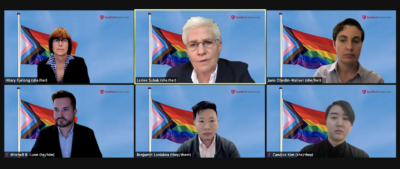Stanford Health Care leaders highlighted health disparities among LGBTQ+ individuals in a Thursday webinar about the emerging LGBTQ+ Health Program designed to serve gender and sexual minorities in the Bay Area and beyond.
According to Stanford Medicine’s Chair of Obstetrics and Gynecology Leslee Subak, Stanford Health Care aims to be a leader within LGBTQ+ healthcare. In September, they earned their fifth consecutive perfect score from the national human rights campaign, “Healthcare Equality Index,” for their LGBTQ+ programs and policies.
LGBTQ+ individuals struggle with an increased risk of psychiatric disorders such as depression and suicidal thoughts, alongside social stigmatization and restricted access to quality care.
“We believe that it’s important other health disparities researchers understand how to interact with populations that are underrepresented in biomedical research and how the benefits of doing research using mobile and digital technologies can actually be done,” nephrology professor Mitchell Lunn said.
Lunn serves as a co-director of the Pride Study alongside gynecology and obstetrics professor Juno Obedin-Maliver. The Pride Study is a long-term study launched in 2015 intended to gather information on LGBTQ+ participants’ social, mental, and physical health experiences through annual surveys.
Using the study’s data, the associated research group has published 13 papers in the last 18 months, related to eating disorders, substance abuse, and mental health issues within the context of the COVID-19 pandemic. The group has also published research on existing healthcare infrastructure and research techniques, in hopes of enhancing the current state of LGBTQ+ health services.
Family medicine doctor and professor Benjamin Laniakea, the head of the LGBTQ+ clinic in Los Altos, said their drive to spearhead minority services stems from an interaction they had in medical school, when a professor stated that his tolerance of LGBTQ+ persons was sufficient to serve the community.
“I couldn’t help but think, wow, we should be so much more than just tolerating,” Laniakea said. “There’s so many steps far and above just being able to step foot into a medical facility and not being shamed.”
The Los Altos facility strives to be a “patient-centered medical home” that focuses on catering to the diverse needs within LGBQT+ community, according to Laniakea. It is staffed by LGBTQ+ specialists, including a social worker and a psychologist. Their primary care providers meet each month to review literature on LGBTQ+ care and most recent standards of practices.
Outside of patient care, Laniakea emphasized the importance of sharing their expertise.
“Part of my job here is also to educate the next generation,” they said. “When I was in medical school, my entire LGBTQ+ curriculum consisted of single question on one exam, and the answer was, it was a gay man with HIV.”
Laniakea now guides Stanford medical school’s integrated LGBTQ+ curriculum and rotations, which enables students to address situations specific to LGBTQ+ communities, such as receiving gender-affirming therapy.
Candice Kim, a joint M.D.-Ph.D. candidate in education, is working on strengthening LGBTQ+ education through the implementation of an evidence-based curriculum on “critical consciousness.”
Instead of merely teaching students facts, this pedagogical model strives to encourage self-reflection, with the end goal of enabling learners to create behavioral changes, according to Kim. The focus is placed on understanding the patients’ interconnected identities, such as the relationships between language, nationality, location and other aspects.
“We still have much work to do, as our current training paradigm is not actually producing the quality of care and the type of physicians we actually would want to be producing.” Kim said.
In a 2017 survey from Center of American Progress, 8% of lesbian, gay, bisexual and queer and 29% of transgender participants encountered a health care provider that refused to see them on the basis of their sexual or gender identity.
Despite the challenges of their work, the panelists had high aspirations for the future, whether spreading their curriculum to other schools or establishing a one-stop facility for all LGBTQ+ patients’ healthcare needs by 2023. For Subak, Stanford’s efforts are the beginning of a shift in healthcare at large.
“One of the things that we are really trying to do is to raise awareness, to raise education, to try to minimize at least explicit bias.” Subak said. “That means training everyone in the hospital… so that we have a welcoming, inclusive, understanding environment.”
“That’s an enormous job, and one that both of our hospitals and our medical schools are willing — and are excited — to take on,” Subak added.
A previous version of this article and its headline misspelled Stanford Health Care. The Daily regrets this error.
Contact Jodie Meng at jomeng ‘at’ stanford.edu.
